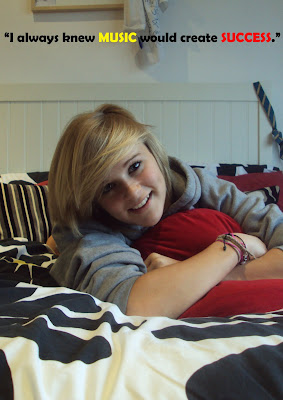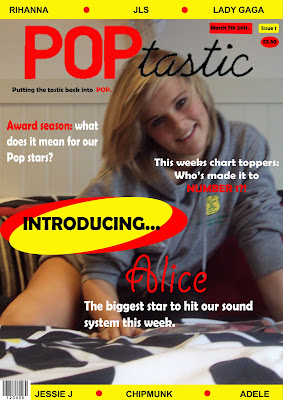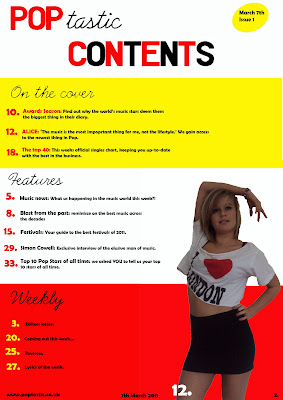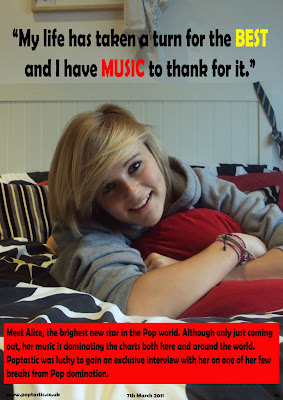Monday 25 April 2011
Evaluation.
http://prezi.com/pv_z30ywvlyo/media-evaluation-as/
Friday 1 April 2011
Feedback from class.
- The target audience is females with the ages ranging from 10-25
- The colour scheme is used throughout and show not only the audience but reflects the genre of music focused on.
- The images are relatable and show the 'star' as having a friendly quality to her.
- The mode of address is accurate for my target audience.
- Some of the photos could do with a different colour background or something else to make it more interesting.
- Some of my text could be made bigger so it stands out more and makes it easier to read.
- My front cover is possibly the weakest item.
Overall, the feedback is positive with a few critical things which I could do to improve my work. The target audience was identified correctly which is a good thing as it means that the work is relatable to the right audience, and is shown through the images and the mode of address.
Evaluation ideas.
Friday 25 March 2011
Final DPS.


Firstly you can see that I have continued using the same colour scheme and font from my other pieces, in order to create continuity and link them all together.
I've used images that portray 'Alice' as a person who the target audience would be able to relate to easily to, due to the the poses as well as the fact that in every image she is looking at you. This will then draw the reader in, making sure the article is read.
The layout of the DPS has the typical qualities that other magazines have. The first page is just one large photo of 'Alice' with a quote above: a feature that is seen in many magazines regardless of the category. The first page also contains a brief introduction to the article, another common feature, with the red background making it stand out and drawing the eye towards it.
The second page's design is very different to the first page. The most obvious clue is the presence of the overlarge speech marks on a background of red, another common code and convention of magazines. As the speech marks are so big, they automatically draw the readers eyes towards the article, whilst the bright colours enforce this. The page is bordered by the thick yellow lines, which creates space for the text and images as well as adding interest to the article.
I decided to structure the article in the style of an interview; showing both the questions and answers. In order to make this clearer to the reader, I put the questions into red whilst leaving the answers in black.
As most articles of this sort take up more than two pages, I decided to include a small arrow at the end of the text on this page to indicate that the article continues on.
Thursday 24 March 2011
DPS drafts: page 2.

This is my starting point for the second page of my DPS. I had decided on one of the images that was going to be used and had started to add some sort of text at the top of the page. I had also added in my giant speech marks, something which is seen in many magazines.
 In my second draft I have added more text to start the article off as well as adding another image at the top, to show even more of 'Alice'. I have also added in the yellow lines which add structure to the piece as well as adding interest.
In my second draft I have added more text to start the article off as well as adding another image at the top, to show even more of 'Alice'. I have also added in the yellow lines which add structure to the piece as well as adding interest.DPS drafts: page 1.

This is my starting point for my DPS. I decided to have a picture as a whole page as that is something that is common in a magazine. I added a quote at the top to give direction to the article, something again which is common in magazines.
Draft 2:
 This is my second draft. I have expanded the quote to make it longer and relate even more to the article on page 2. I have also added a box at the bottom of the page with more text to explain what the article is about. I used a red background for it so it stands out and follows the colour scheme. I have also added 'Alice's' name in a large yellow circle so the reader knows who the article is about, however I don't think it looks that good so I will remove it.
This is my second draft. I have expanded the quote to make it longer and relate even more to the article on page 2. I have also added a box at the bottom of the page with more text to explain what the article is about. I used a red background for it so it stands out and follows the colour scheme. I have also added 'Alice's' name in a large yellow circle so the reader knows who the article is about, however I don't think it looks that good so I will remove it.
Wednesday 23 March 2011
Final Contents page

New Front Cover

I have tried to include all the things that I was told to improve on. Firstly there is the image. I have completely changed the picture to one that contained a natural background as it meant I wouldn't have the trouble of finding a colour to be put as a background and having to cut out the picture; something which didn't go well before. The image also looks more natural and relaxed which is how I wanted to present 'Alice' in the first place.
The colour scheme has changed as well, to fit in with some of the colours that are in the image. I chose red, yellow, black and white as they are colours that can be associated with Pop and they are relevant to the target audience's age as they suggest youthfulness.
To make the main part of the text stand out, I put the word 'INTRODUCING' into two circles of red and yellow, which automatically draws the eye which would make the reader pick up the magazine. I then put Alice's name into a different text to make that stand out from the rest of the page and to show that it is the main article of the issue.
At the top and bottom of the page are banners with Pop artists names in them. This is something that I had seen in other magazines and thought it would be relevant for mine as it was an opportunity to show who else is in the magazine without having lots of text, and adding variation to the page.
Friday 11 March 2011
Feedback for front cover.
- Experimenting with changing the picture in order to lose lots of the blank space.
- Making the masthead larger
- Moving around the text on the cover
- Putting text in block colours in order to make it stand out more.
- Making the main story bigger.
- Possibly putting other pictures on the cover.
- Changing the colour scheme- the background colour in particular.
- Changing the font .
Thursday 10 March 2011
Contents page drafts.
I have started to include some articles onto the page. The headings of each category are in the other font from the masthead, with the smaller text in the other font from the front cover to link them together. I have used the colour red for the page numbers as it is one of the colours in the masthead and stands out on the background:

Here is the first stage of my contents page.
I continued the colour scheme from my first front cover onto the contents page to add continuity. I have chosen my image which links to the one from my front cover. The masthead is also present in the top corner. I have continued to use one of the fonts from my masthead as it is bold and gets the page title across clearly.

*
After gaining feedback for my front cover, I had to change aspects of my content page so that they looked similar.
Monday 7 March 2011
Final Front cover design.

Thursday 3 March 2011
Front cover drafts

Above is my starting point as such for my front cover, showing the masthead and central dominant image as a basis for the rest of the page.

Next is the second draft, where you can clearly see that the colour of the masthead has changed to a bright red. As mentioned in other blog posts, I talked about the idea of using a colour like red as part of my masthead in order to attract a male and female audience, the likes of which are seen on various early Smash Hits front covers.

Front Cover picture.

This is the same picture, but it has been edited in order for it to look right on the front cover. I have taken the background of the original image off, as it looked grey and boring. The picture can now be adapted for any background colour.

In the end, I decided to add a background colour to my picture to make it easier for the background of the front cover. I chose pale blue, as it is a colour that could appeal to both boys and girls and so hitting the criteria of my magazine.
Font choice.
The first is a bold text called Beer, for the word 'Pop'. I wanted a bold and big font for this, so it stands out and makes the genre of the magazine clear to see.
The second font is called Prelude FLF for the word 'tastic'. I chose an italic style font as it was a contrast to the word 'Pop', and makes the masthead look more interesting.
Saturday 26 February 2011
Photo's for magazine.
Here are the images I have taken to be incorporated into selected pages of my music magazine. I have decided that the 'star' of this issue is an 'up and coming solo artist who is the same age as the target audience'. The pictures are in two sections. The first section reflects the normality of the star, as suggests an interview about all aspects of her life. The second section is the more glamorous photo's which show the star in the 'pop star life'. All the images suggest a fun and loveable person who is easy to engage with and so they will make good photos for a magazine as the reader will engage with the 'pop star'.
Monday 7 February 2011
Pre-lim task: School magazine contents page.

I based the page on the lifestyle magazine I have previously analysed, as they only incororate one image into the page. I chose this image as I believed it showed St. Andrews in a good light, with students working, but also sets an example to the younger years, who are the target audience for this magazine. The magazine title has been placed at the top left-hand corner, so that the reader knows what they are reading, as well as being a continuity issue. I used black text as it is simplistic and ordianry, with red for the titles of each page to make them stand out.
Thursday 27 January 2011
Content page analysis, Mens lifestyle magazine: FHM.
"Men, aged 18-35. FHM is broad in its appeal, and has a wide range of readers and users, typified by mid-twenties ‘work hard, play hard’ guys. In the early stages of their careers and with an eye to the future, FHM readers are typically professionals, office workers, and university-educated. They may be dating or living with a girlfriend, but they still take holidays with their mates. With good incomes and few financial commitments, these are high-value consumers, eager to invest in fashion, grooming, gadgets, travel and cars."


Like Glamour magazine, the contents page is across two pages, which means that the content of the page can be spread out and more images can be used to show a visual means of letting the readers know what is shown in the magazine. However the first contents page shows and elaborates on the articles show on the front cover. Underneath each title on this page, there is a brief-ish description of what the article is about, which is unusual for a contents page, as they usually just give a title with a line underneath. As these articles are the ones on the front cover, they have some importance to the specific issue, and so they have a description to let the reader what is so important about the articles and to make the reader read on. On the other page though, there are all the other articles in page order without the brief descriptions like the other page. They are split up into sections, and each section has a description underneath of what each section is about.
On the first page, there are eight images present, but five or six of them are just small images of each DPS that is talked about on the page. This means that is is easy for the reader to relate the article to the image on the contents page, and it means that the magazine didn't have to get more images to show the content of the same articles. On the next page, there is just one dominant image that takes up nearly the whole page, apart from a small panel along the left-hand side. This image is of the 'December Girlfriend' and shows the other side to FHM; the women. As this is the only image on this page, it gives the article itself importance.
The contents pages are really structured, with the articles in page order on the left-hand side and the images all on the right. This is a continuity thing as it is present in all the FHM magazines and it makes the page easier to read as you know all the text is in a certain place.
The pages don't contain a logo or the title of the magazine to remind readers of what they are reading, but at the top of the page is the word 'contents' in capitals and in red. On the next page is the word 'regulars' in exactly the same style, just smaller. The use of capitals and a bold colour like red, make the words stand out on the white background so that the reader can see the title of the page easily. The red used is the red from the title, showing continuity in the magazine. Also the titles are boxed off making them separate from the rest of the page, which makes them stand out.
All the text is in black apart from the page numbers that are in red, making them stand out. The titles of each article are in bold and capitals, which lets the reader know that they are the titles. The rest of the text is ordinary looking meaning that it is easy to overlook, and so the reader actually has to read the page instead of just glance over it.
Contents page analysis, Women's lifestyle magazine: Glamour.
"Glamour is a magazine that translates style and trends for the real lives of American women. Our award-winning editorial covers the most pressing interests of our 12.4 million readers: from beauty, fashion and health to politics, Hollywood and relationships. We’re often optimistic, always inclusive, beyond empowering and can always separate the Dos from the Don’ts.
Our readers live for fashion, live for beauty and most of all, live for Glamour."


The contents page of this magazine is spread across two pages, meaning that the page can feature larger pictures and can spread out the text on the page making it easier to read.
Firstly the page only really contains one large and dominant image on the first page, that relates to one of the articles in the magazine. Although on the second page it may look like their are other images, these are with regards to a competition, and so are not relevant to the contents pages. This one image, however suggests that this article, which happens to be a fashion shoot, is the most important in the magazine. As it is a fashion based article and the mission statement states that their readers "live for fashion", it makes sense that this image is the main one. Yet there are no images relating to the front cover, which you would assume to be the main article in the magazine. The use of one image is very unusual for a contents page, yet it does mean that the reader can get a sense of what the magazine classes as important easily as well as making the page look less cluttered and more structured.
The page doesn't show a logo, but at the top of the first page 'Glamour' is present, in a large font and in bright colours making it stand out on the white background of the page. The bright colours also give the page a fresh and cheerful feel to it as they are reds, oranges and yellows; which is fitting for a 'new season'. The title is also present on the other page but slightly smaller as it isn't the main contents page. 'Glamour' is all in capital letters giving it a bold look about it, which also goes with the colour scheme.
Underneath the title is the website address (www.glamour.com) and the issue date (February 2011). These two are in black and are in a font which gives the text a slight edge. Again this is present underneath the title on contents page two which provides continuity for the magazine.
The articles are separated in sections like in most magazines, meaning that the reader can find articles easily as well as giving the page a structure. The section titles are in the colours of the the title: so the colour of one section is the colour of one of the letters of the title. Again this provides continuity for the readers across the two pages, as well as giving the page a splash of colour which makes the page more eye-catching.
The rest of the text on the page is in black and in a standard font such as Time New Roman, which means that the text doesn't stand out as much as the coloured text. The titles of each article are in bold though which does make them stand out more then the other bits of text, but the reader still has to read the page in order to find out what content is in the magazine. However the text on the large image, although follows the same pattern as the others, is larger making it easier to see and read.
Thursday 6 January 2011
Analysis of a Double Page Spread: Smash Hits.
 This is a DPS from the special edition Smash Hits which is entirely focused on Lady Gaga.
This is a DPS from the special edition Smash Hits which is entirely focused on Lady Gaga. Analysis of a Double Page Spread: X Magazine.
 This image of this DPS is from the fashion part of the X Magazine.
This image of this DPS is from the fashion part of the X Magazine. As it is focusing on fashion, there are more images on the page than text, and as you can see, there are six large images with six smaller pictures which complement each other. As the focus of this particular page is of everyday people and their fashion choices, it makes sense that they are the larger images. This also means that the reader is drawn to them more and so they will take note of what ordinary people aspire to dress like, which is the point of the magazine. The purpose of the magazine is to make women aspire to be like certain celebrities and this is achieved in this article but putting the music style icons for each person at the bottom of the page. Again this means that the reader focuses on the larger images instead of the smaller, as everyday we see what the famous style icons wear.
The title of this article is simple: 'Your Pop Style Liverpool'. The use of the word 'pop' means that the music element of the magazine is included into the article, and it also makes the title sound more feminine. 'Liverpool' is included to let the reader know where these particular group of people live and it also give the impression that this is a continuous thing; every issue of the magazine shows that same page but with people from a different place each time. This will make the reader intrested in the article and the magazine itself and so are more likely to continue buying it.
Although the page doesn't contain the X Magazine logo, it does include the 'logo' for the section which is show on the contents page: 'Style File'. This lets the reader know what section of the magazine they are reading without having to read the article itself.
The page itself has a very feminine feel to it, which is fitting for the topic of the article. This is achieved by the use of colour and font in particular. The title is in italics which gives it the stylish look it needs, with the black and pink writing making it seem feminine. Also as the title isn't in bold which means it doesn't stand out as much and makes the whole title look like something that a female would write in the first place. As the background is in white, the pink of the title along with the other parts of pink writing show up and adds to this feminine feel.
As already mentioned, there is more images than text on this DPS, however the text that is present explains to the reader, why this person chooses to dress like the music icon they have chosen. The language is informal and casual as it is what the person is saying and so can be related to more by the reader.



